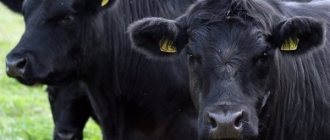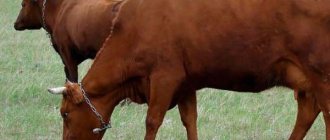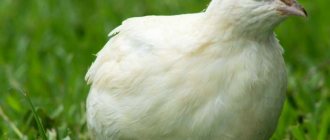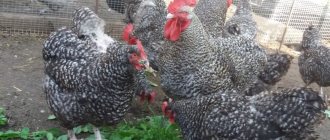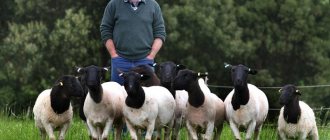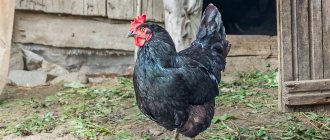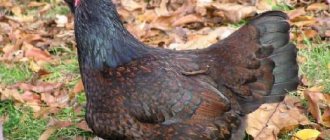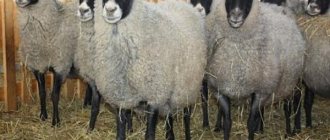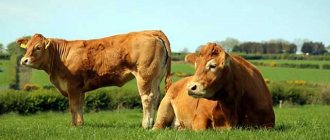Poultry farming » Chickens
2
4575
Article rating
Kira Stoletova
At the moment, a huge number of different breeds of chickens are known, thanks to which farmers have a wide choice. The decisive factor when choosing laying hens is their productivity. If variegated colors and broiler carcass are not important to you, then you can pay attention to Dekalb White chickens.
Dekalb White chicken breed
This variety was created in order to produce large eggs in large quantities, regardless of the time of year and the effort expended in caring for the birds. With the help of this article, you will have the opportunity to find out more detailed information about the origin of laying hens, their characteristics and care features.
Cross history
DeKalb chickens are a new egg-laying cross that was bred in the USA. The creation of this species was carried out by the company Dekalb Poltri Research. At first, the company produced fertilizers with hybrid seeds. In the 60s of the 20th century, the “Princess of Poultry” was introduced - this is the name given to the bird.
During the creation of this species, the main goal was to obtain a bird with high productivity and a long period of laying eggs. The bird had to produce eggs of the highest quality.
Today the company is the main and largest supplier of Dekalbs. Breeders continue to actively work to improve the cross. There is a high probability that over time the productive properties of the described cross of birds will increase.
Exterior of a bird
In appearance, this cross is practically no different from other white chickens. Dekalb has a compact body, the body is of medium size, the skeleton is very light, the chest protrudes slightly forward, round in shape, and the belly is voluminous. The head is not too large, the leaf-shaped comb is slightly tilted to one side, and like the earrings it is colored red.
The plumage is well padded and can be not only white, but also brown. The beak is small, yellow, strong. The weight of an adult bird reaches 1.5-1.8 kg, males - about 2 kg.
There is not too much difference in the herd not only in the level of egg production, but also in the weight of eggs. This quality is valued specifically in the case of breeding birds on an industrial scale.
Dekalb are unpretentious birds, so they will feel quite comfortable both in cages or a poultry house, and in an aviary.
External characteristics
Let's consider several main characteristics of the appearance of this breed.
- First of all, it is worth noting the weight indicators in order to have an idea of what size chickens we are talking about. So, cockerels can gain weight from 2.7 to 3.2 kg, and hens are about 500 grams less. It is known that the black line is famous for its high weight and egg production, so farmers often prefer it.
- The bird's body is voluminous, with rounded shapes and pronounced muscles, like many meat-egg blackbirds, which is not typical for an egg-laying cross. Wide back and chest, pronounced hips and fleshy legs. The belly is low and the paws are widely spaced.
- The birds have a small head, with bright, expressive eyes. The iris of the eyes is colored orange. Facial skin color is red. The earrings and the erect, leaf-shaped comb are of the same shade.
- The plumage is thick, of medium density - not very hard, on a downy “base”. The wings are small, fit tightly to the body and are also densely feathered. As for colors, there are different ones. Black is the most popular among poultry farmers. There are also pockmarked, white with a black mane (similar to Adlers) and brown.
Czech laying hens are not known for their temperament. They are calm, moderately active, but terribly noisy - with them the farmstead will always be filled with vociferous singing and cackling
It is important to note that Petkas are not pugnacious; they easily accept representatives of other breeds and species into their circle.
Farmers note that chickens can be a little timid and experience stress if they change their owner or place of residence, but this does not affect the quality of the clutch.
Early birds have always been valued by farmers because they are less expensive to maintain. Therefore, scientists have always sought to breed varieties with a tendency to early egg-laying. The Dominant breed of chickens, the description of which suggests that it begins laying at approximately the age of 5-6 months. But the growth process does not end there - the herd will gain weight for up to 11 months, sometimes longer.
Some hens do not mature as quickly, and may lay eggs closer to 7 months. But, according to reviews from farmers, such birds will remain productive longer, which is also an advantage.
Dominants are famous for their egg-laying merits. Indeed, today there are few laying hens that could produce up to 320 eggs per year with minimal feed costs, without additives to stimulate laying! The eggs are covered with shells of brown shades - from brown to dark, bottle-like.
The average weight of eggs is about 65 grams, but at the peak of laying they can be larger.
Productivity
Laying hens today show maximum egg mass. Active attempts by breeders have led to the creation of a species whose laying hens can produce 330 eggs in just one year. The average weight of one egg ranges from 60-64 g. The white (White) Dekalb chicken produces eggs with a light shell, while the Dekalb Brown egg has a brown hue.
One of the main features of the cross is maturation in a short time. As a result, the laying period begins at 4 or 5 months. About 95% falls at 40-41 weeks.
There are no too strong differences between Dekalb and other egg crosses of birds. But it is precisely this species that is gradually and persistently replacing other laying hens in both private and industrial farms. Dekalb gives some of the best performance, which is slightly superior to such a common type as Hisex.
In the following video, the breeder talks about the productivity of Dekalb chickens:
Natural decrease in egg production
The onset of molting is often associated with a natural decrease in productivity. Molting occurs at 63-67 weeks. Artificial exposure to chickens can speed up the molting period. To do this, you need to adhere to the following tips:
- daylight hours decrease, which should be closer to the 2 hour mark;
- Only the drinking bowl with water is left and the food is removed;
- approximately 10 days later, after the food and light regime is limited, light levels are gradually increased (by 30 minutes per day);
- then the feeding of the bird changes - the calorie content of the food increases, which should be greater than before the start of molting.
Thanks to this type of forced molting, the unproductive period decreases, which instead of 60 days will last no more than 45 days. During all this time, the bird does not lay eggs at all. After the plumage changes, clutch activity resumes.
general characteristics
Many poultry farmers consider breeding this cross to be a very profitable business, because chickens provide a high-quality product all year round, without requiring special conditions for keeping and needing a small amount of feed.
And although they are not much different from their relatives in appearance, they still hold the lead in prevalence. Let's take a closer look at what caused this.
Egg breeds of chickens also include breeds such as Ameraucana, Shaver, Legbar, Xin Xin Dian, Minorca, Leghorn.
Appearance
The breed standard provides for a clear exterior, deviations from which are considered disqualification of the bird. It is necessary to know the peculiarities of the appearance of purebred chickens in order not to fall on the hook of unscrupulous poultry sellers.
The table below will help you with this:
| Features of the appearance of chickens of the Dekalb White breed | |
| Head | small (smaller than medium size) |
| Crest | leaf-shaped, bright red, large, often hangs to one side, covering one eye (the Dekalbs surpassed even their close relatives the Hayseks in the size of their crest) |
| Beak | small, strong, dirty yellow |
| Eyes | dark or brown-red |
| Neck | short and wide |
| Breast | protrudes slightly forward, slightly rounded |
| Torso | compact, medium size |
| Stomach | quite voluminous |
| Backbone | easy |
| Wings | small |
| Tail | long, but not very curvy |
| Back | not wide, thin |
| Paws | short but stable |
| Plumage and color | white, the feather cover is not thick, but dense (during the period of maximum egg production, chickens look ragged due to a lack of nutrients) |
Productive qualities
The Dekalb White breed represents the egg type of chickens and today demonstrates maximum egg laying rates. But along with this advantage, the representatives of the cross under consideration are poor hens and have skinny carcasses.
Important! To determine the freshness of a chicken egg at home, you need to dip it in a glass of water - a fresh product will sink, and a stale one will float. More detailed information on the productivity of purebred birds is presented in the table below
More detailed information on the productivity of purebred birds is presented in the table below.
| Characteristics of the productivity of chickens of the Dekalb white breed | ||
| Weight of adults, kg | Chicken | 1,5–1,7 |
| rooster | 1,8–2,5 | |
| Weight of a day-old chick, g | 40 | |
| Breed direction | egg | |
| Puberty period | 4.5–5 months (peak egg laying occurs at 40 weeks of life) | |
| Average annual egg production | about 330–350 eggs | |
| Egg qualities | mass, g | 60–63 |
| shell color | light | |
| shell quality | strong | |
| Taste qualities of meat | high | |
| Hatching instinct | very low (planting such a hen is not profitable due to the loss of about 22 eggs that she could lay during this time) | |
| Livestock safety, % | young animals | 99,4 |
| adults | 96,5 |
Important! To preserve the main features of the Dekalb breed, experienced poultry farmers advise buying a purebred rooster from another farm once every couple of years.
Temperament
Representatives of the Dekalbov breed are distinguished by:
- peacefulness;
- calm disposition;
- moderate activity.
However, a significant drawback of chickens is their poor adaptation to new conditions and low stress resistance. In addition, the described birds are characterized by increased timidity and, therefore, because of this, they can cause discomfort with their loud cackling.
Advantages and disadvantages
Regardless of the goals of breeding chickens, choosing a breed always requires a scrupulous analysis of all its advantages and disadvantages.
- Advantages
- high egg production (especially in the first years of life);
- precocity;
- good quality eggs (large size, appropriate weight and satisfactory shell density);
- almost one hundred percent survival rate of livestock;
- friendly disposition;
- small need for food (for adults, the daily portion of food does not exceed 100 g);
- high immunity, resistance to common chicken diseases;
- undemanding conditions of detention.
- Flaws
- poor adaptation to new conditions (Dekalbs react especially painfully to a change in their familiar environment);
- low stress resistance;
- excessive fearfulness;
- noisiness;
- poorly developed maternal instincts;
- unsuitable for meat purposes.
Advantages and disadvantages of cross
This bird has both advantages and certain disadvantages. The main advantages include such qualities as:
- high egg production;
- large eggs;
- puberty occurs early;
- there is the possibility of keeping birds in cages (how to make a cage for chickens with your own hands is written here);
- calm and peaceful character;
- unpretentiousness to living conditions.
The disadvantages include:
- laying hens do not have a brooding instinct;
- short period of productivity.
The main disadvantage of the Dekalb cross is the almost complete absence of incubation. If you plan to independently breed crosses and hatch chickens, you need to additionally look for a hen, but only of a different “breed”. You can also use an incubator.
The herd is changed every 2 years, which is one of the disadvantages of cross-breeding. Keeping birds for a longer period of time does not make any sense, since after this time a sharp decrease in productivity is observed.
Advantages of the breed
The Dekalbs' character is not chicken-like at all. They are surprisingly calm and not fussy. They do not require a lot of space for their maintenance, so they live comfortably in cages, aviaries or joint poultry houses. Chickens are not able to fly, so their enclosures are built very low, without additional fences. Dekalbs also surprise with their unpretentiousness in food. Even with an undiversified diet, chickens rarely get sick. Their daily food intake is below average. Keeping such chickens is financially profitable.
Main advantages:
- The Dekalb breed is famous for birds with strong immunity. They are very resistant to a number of diseases. They are vaccinated only when there is a large population.
- They eat little and do not require variety in their diet.
- The Dekalb breed demonstrates a productive cross. One chicken produces 320-340 eggs per year. The eggs are large – they weigh around 65 g.
- Very strong eggshell, due to which eggs are rarely infected (for example, with salmonellosis).
- Very high survival rate among chicks. The figure reaches 98%.
- They are developing quickly. Laying hens can lay their first eggs at the age of 4 months.
- Calm behavior.
Keeping Dekalb chickens
Dekalb is one of the comfortable crosses that is recommended for beginning farmers, especially if the main goal is to obtain a large number of large eggs.
When purchasing birds, certain standards must be taken into account:
- In a chicken coop for 1 sq. m there should be no more than 5 laying hens. Thanks to this indicator, the birds will not freeze in winter. If this indicator is exceeded, pecking and a later period of onset of puberty may occur.
- When building a chicken coop, the choice is a concrete or earthen floor. If a wooden type of covering is used, the boards must first be impregnated with special solutions. The earthen floor must be covered with deep bedding.
For a large farm, a concrete floor is an ideal choice, but with a minimum number of livestock this may not be justified.
- For the chicken coop, choose a dry place that is located on a hill. The relief is important, since the earthen floor will actively absorb water. If the poultry house is located in a lowland, crushed stone must be poured on top of the floor in a layer of about 20 cm.
- The ideal covering would be dry peat, sawdust or straw.
Preliminary disinfection of the floor surface is carried out. To obtain deep litter, the layer must be at least 15 cm thick, but it must first be dried well. If necessary, a new layer is periodically laid out. Good bedding and sufficiently dense planting of birds allows you to keep the chicken coop warm during frosts. - On the south side a bird hole is being constructed. Construct a small threshold, about 5-6 cm high from the floor. The height of the hole should be 30 cm.
If you need advice on how to make your own chicken coop, this article is here.
Ventilation and lighting
Do not allow strong drafts in the chicken coop. Careful sealing of all holes and cracks in the walls will help to avoid this; it is advisable to install double-glazed windows on the walls. Ventilation is arranged using a door and a window, however, this option is extremely undesirable. It is not only ineffective, but also provokes rapid heat loss.
A good choice would be to install special mechanical ventilation using a fan and an exhaust pipe. This option is most suitable for large farms. But for small chicken coops, too much electricity costs will not be justified.
It is rational and simple to install supply and exhaust pipes, the diameter of which should be about 200 mm. The exhaust pipe is installed directly under the ceiling so that it protrudes approximately 1 m above the roof. A supply pipe is installed no lower than 30 cm from the floor, which should protrude 40 cm above the roof.
Thanks to this type of pipe arrangement, it becomes possible to carry out passive and effective ventilation. The main advantage is that no heat will be lost during ventilation.
Using incandescent lamps, the correct light conditions are maintained, and the room will also be heated. It is important that the daylight hours are approximately 15 hours, so that chickens can lay eggs effectively even in winter.
Interior arrangement of the chicken coop
When arranging a chicken coop, special attention should be paid to the number of nests. The height of egg production must also be taken into account - every day 10 hens will produce approximately 8 eggs. Therefore, for 10 laying hens there should be at least 3 nests. The perches are located at a height of about 90 cm from the floor and several floors high.
These birds are quite light, so perches in several tiers do not cause any difficulties. It is also convenient to arrange horizontal versions of perches, which occupy a large area, but the chickens will not get dirty from the droppings of birds sitting above. You can additionally install bars, the width of which is about 5 cm.
The largest amount of droppings is always collected under the perch. To prevent the spread of infection, cleaning is required as often as possible.
Clean water must be present in the chicken coop. You can use various drinker options:
- vertical;
- nipple;
- simple bowl.
How to make a drinking bowl with your own hands - read here.
In order for birds to regularly clean their feathers, they need simple ash. You can install a bowl of ash both indoors and outdoors. If the ash bath is located inside the coop, it will create excess dust. But for winter this is the most suitable option.
Chicken nutrition
Food is given at least 4 times, but only in small quantities. It is forbidden to take too long intervals between feedings. A feature of this bird cross is its accelerated metabolism.
60% of the total diet should be consumed in the second half of the day. It is at night that the active ripening of eggs begins.
The following components should be present in the diet of Dekalb chickens:
- Approximately 60% of the nutritional mixture consists of crushed grains. But it cannot be just one culture. The ideal option would be to mix several types at the same time. The priority should be corn, including wheat; barley in combination with oats is suitable.
- Fresh greens are an essential part of a bird's diet. The greatest benefits come from alfalfa and fresh nettle. It is worth preparing herbal flour for the winter period of the year; it is recommended to purchase ready-made herbal granules in specialized stores.
- The food is supplemented with foods that will be sources of calcium necessary for the proper formation of egg shells. If a chicken lays a lot of eggs, this leads to depletion of this microelement in the body. You can avoid this trouble if you add eggshells, finely ground shells or simple chalk to your diet.
- Add salt to the feed. Yeast, cake, and fishmeal are also suitable.
An excellent alternative would be special mixtures designed for laying hens. These types of feed contain all the substances necessary for birds during the beginning of active laying.
Each bird needs 100 g of feed per day. It is not recommended to feed too much food, as there is a risk of obesity and decreased productivity. If sudden menu changes occur, the number of eggs may decrease for a while.
What to feed
For feeding birds of this breed (chickens and adult birds), the feed used for feeding other egg-laying chickens is suitable.
Chickens
Newly hatched chickens are fed the yolk of a hard-boiled chicken egg, and low-fat cottage cheese is mixed into the yolk. From the fourth day of existence, cereals (millet, cellulose) and finely chopped greens are introduced into their diet. Then add grated vegetables, meat and bone meal and, if necessary, mineral or vitamin supplements.
Find out more about keeping and feeding laying hens: how to make feed at home, germinating wheat for chickens, what vitamins are needed for egg production.
Adult chickens
A chicken eats about 100 grams of feed per day. The best food for adult chickens is feed intended for egg breeds. They are perfectly balanced, but relatively expensive. You can get by with cheaper, self-prepared mixtures, which also ensure high productivity of laying hens. For example, a mixture of the following composition has proven itself well:
- corn - 40% of the total mass;
- wheat - 20%;
- barley - 7.5%;
- sunflower meal - 11.5%;
- yeast - 3%;
- fish meal - 5%;
- herbal flour - 4%;
- chalk - 3%;
- shell - 4.5%
- salt - 0.5%;
- premix - 1%.
Important! For any type of feeding, you need to add greens to the food (alfalfa, clover, nettle, etc.): freshly chopped, in the form of grass meal or grass granules. In winter, greens can be replaced with hay.
Chick development
Since the activity of laying hens decreases with age, it is recommended to breed young animals every 2 years. Chickens of this cross are almost completely devoid of the brooding instinct, so you will need to additionally purchase an incubator. You can also give eggs to hens of other breeds, of course, if there is such an opportunity.
Dekalb is characterized by good fertilization rates - about 95% of eggs can be used to hatch chicks. If an incubator is used, this figure drops to almost 80%. Approximately 90% of hatched chicks survive safely.
Watch a review of Dekalb chickens in the video below:
Eggs that are no more than 5 days old are suitable for incubation. It is important that they have no defects and are approximately the same size. Before placing an egg in the incubator, it is recommended to examine it with an ovoscope, which will help to accurately exclude the possibility of developmental disorders.
To hatch young animals, it is not recommended to take eggs from young chickens that lay eggs no longer than 3 months. The fact is that this type of egg is not fertilized, since Dekalb’s period of puberty is delayed relative to the beginning of laying.
Incubation
The duration of egg maturation is 20 days. How successful the hatching will be depends on the temperature regime. The level of air humidity and the quality of the eggs used are important. An ovoscopy test eliminates the possibility of two yolks, dark gray spots under the shell, embryo death, or fungal signs.
After the inspection is completed, all eggs are disinfected using simple potassium permanganate or Ecocide. After this, the eggs are laid in the incubator. It is necessary to take care of the temperature and humidity level (about 60%).
The maturation of embryos and the subsequent hatching of chicks should take place in conditions as close as possible to natural ones. If the chicks are overheated, they will hatch quickly, but will be weak and sickly. Chicks that have been underheated will have some problems with the umbilical cord healing process.
First days after incubation
In the first 10 days after hatching, chickens need special care. Before the young animal reaches 5 days of age, it is placed in a spacious wooden box, the bottom of which is covered with a layer of paper, and a grate is placed on top.
It is not recommended to use additional bedding, as the chicks have sensitive feet and are at risk of injury.
The chicks are fed corn grits or millet. At night, the box needs to be additionally heated using infrared lamps; on warm sunny days it can be taken outside.
In the first days of life of chicks, a comfortable temperature is about 30 degrees. Gradually it can be lowered to 26 degrees. After the birds are 4 weeks old, the temperature is allowed to be reduced to 18 degrees. Gradually, the offspring become accustomed to walking.
Feeding the chicks
The chicks are fed taking into account the following recommendations:
- the first 10 days after hatching - hard-boiled eggs, cereals, chopped herbs;
- from the 10th day of life, eggs are gradually removed and replaced with compound feed, which should contain 23% protein;
- while growing up, chickens are fed grain, which is better absorbed in combination with chopped greens;
- grown-up young animals are given fish oil - no more than 1 g per 1 chicken;
- gradually boiled root vegetables are introduced into the diet;
- when the chicks reach 8 days of age, you can give raw root vegetables;
- Young animals must always have access to fresh and clean water, but it cannot be cold.
Disinfect drinkers and feeders regularly.
Conditions of detention
They set up a dry and fairly warm pen, but only outside the poultry house. It is important that there is proper ventilation in it; even a slight draft should not be allowed.
For 1 sq. m of room should be no more than 20 chicks. After 6 weeks per 1 sq. m should have no more than 17 chicks, after 12 weeks - 10 chicks.
Diseases
Despite the fact that Dekalbs rarely get sick and have high immunity, they, like all birds, are susceptible to illnesses.
Hypovitaminosis
- lack of vitamin A. Weight loss, inflammation of the mucous membranes of the eyes, lack of activity. Contained in carrots, greens;
- vitamin B deficiency. Feather loss, head thrown back. It is recommended to add more sprouted grains and yeast to the diet;
- lack of vitamin D. The appearance of rickets, curvature of the legs and beak in chicks. For prevention, fish oil is needed.
Pecking
This problem only affects laying hens, which pull out each other's feathers, pinch and eat eggs. Occurs when kept in close quarters, bright light, lack of nutrition, lack of exercise. To avoid such an unpleasant phenomenon, experienced farmers recommend leaving a dim red light in the chicken coop as a preventive measure.
Overheating
Can ruin the quality of eggs. Subsequently, they have a thin and crumbly shell. The chicks show weakness and constant thirst as symptoms. To solve the problem, build a shelter and provide free access to fresh water.
Reviews from poultry farmers about Dekalb chickens
★★★★★
Ekaterina, 30 years old, economist, Sumy. They tried to persuade me to take this particular cross for a long time, but I still didn’t dare.
After reading the characteristics, I decided to take it. I bought it at a poultry farm, everything was official, so there was no doubt that the chickens belonged to this breed. At 5 months the hens began to lay eggs and the eggs were large. But during the molting period there is a short break. To prevent egg production from dropping in winter, I use additional lighting.
★★★★★
Dmitry, 40 years old, economist, Voronezh. I don’t really understand how exactly the Dekalb differs from other breeds and crosses in terms of external characteristics.
There are practically no differences in chickens, but when the hens are fully grown and the laying period begins, it becomes noticeable and visible. What made Dekalb special for me was the size of the eggs - they are almost all the same size and weight. Therefore, this type is a priority for me. Hide
Add your review
Dekalb chickens have valuable productive qualities, which makes them different from other industrial egg crosses. Today this cross is beginning to enjoy great popularity in Russia not only among experienced but also beginning farmers.
0
0
Copy link
Description
Externally, the Dekalb White chicken breed is unremarkable. According to the description, the Dekalb chicken breed can easily be confused with other egg-laying crosses and breeds that have a similar color scheme:
However, to distinguish these crosses “live” you also need to have considerable experience. Beginners in poultry farming are not immune to mistakes.
In the video it is noticeable that the only thing that can be distinguished from Leghorn is the rooster, which has a very fleshy and low comb.
The description of the Dekalb chicken breed states that they have a medium-sized body with light bones. The head is small, with a large leaf-shaped crest that slopes to the side. Earrings and comb are deep red. The earlobes and face are pink. The neck is long, covered with well-developed feathers. The eyes are orange-red. The beak is short and yellow. The body is placed almost vertically. The back is straight. The tail is narrow, but well developed.
